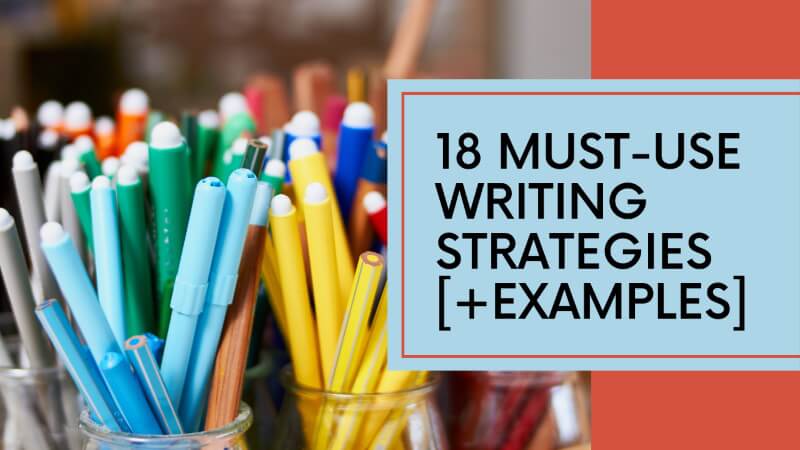18 Must-Use Writing Strategies [+Examples]

Have you ever watched a movie and, out of nowhere, a scene takes place that is somehow so “off” that it jars you out of the narrative and back to reality? Sloppy storytelling is confusing and frustrating, whether it’s in a movie or on a website.
A blog post or article will succeed or fail based on whether it engages the audience in a clear and consistent way. Here are nine writing strategies that can help you snag your readers and keep them interested.
1. A Captivating Opening Sentence
There’s a reason this is the number one writing strategy on this list. Don’t assume readers are automatically interested in your subject. Write something catchy that will make them interested.
Example: “Have you ever watched a movie and, out of nowhere, a scene takes place that is somehow so “off” that it jars you out of the narrative and back to reality?”
Okay, maybe I’m just tooting my own horn here, but most people have watched movies, most people can relate to this experience, and it serves as a pretty relevant introduction to the subject matter. For more info, Problogger discusses how to open your next blog post.
2. A Sense of Direction: The Opening Paragraph
The opening paragraph of an article is like a travel itinerary. It should tell readers where they’ll be going and what they’ll find there. Make it creative or make it straightforward, but always make it clear.
3. A Tone of Sincerity
Just because you’re not sitting right beside your reader doesn’t mean that the basic rules of human interaction don’t apply. Readers are looking for clues into your authenticity, and insincerity is as distasteful on the page as it is at a cocktail party. Convey your passion and authority in a subject or your readers will ditch you.
4. Speak to Your Audience

Who is reading your article? What is their life like? Do they have a family? Are they starting a career? Knowing why someone is coming to your article is a major step in knowing what to say to them and, most importantly, how to appeal to them on an emotional level.
Example: “Your family’s safety is your number one concern. Whether you plan to travel or stay at home this holiday season, we have all the safety tips you need to keep everyone safe, healthy and happy during the holidays.”
Copyblogger explains how to really connect with your blog’s audience.
5. The Value of an Outline
You learned it in freshman composition class and it’s just as important now. An outline is an effective writing strategy that will get you from A to Z without leading your reader through a maze of digressions and secondary thoughts. Know what you want to say in an article before you say it. Try this:
Short opening paragraph
- Subheading 1
Summary sentence - Subheading 2
Summary sentence - Subheading 3
Summary sentence
6. Have Fun
This is one of the most important writing strategies for success, yet it’s rarely discussed. Simply put, if you don’t enjoy what you are writing about or at least find some value in writing about it, your disinterest will seep into the article and your words will fall flat. Find something to enjoy in what you’re writing; interest will make your content sparkle.
7. Open a Dialogue
You wouldn’t speak in person to a group of interested people and expect them not to converse with you, so don’t make that mistake in your writing. When writing a blog post or article, remember that you’re actually having a conversation.
Example: “This is just a list of how I like to keep my office organized. If you have some of your own I’d love to hear about them!”
8. Timing is Everything

Timeliness cuts through the fog of an oversaturated internet. If you’re writing on a subject that’s topping the headlines, put a new spin on it. If your subject is as old as time itself, present it in a modern, relevant light.
Example: Ten Everyday Things You Have in Common With Ancient Egyptians
9. Above All Else, Be Clear
The great writer George Orwell once said that good writing is like a clear pane of glass. Clarity is the all-important hallmark of good writing. Don’t confuse your reader. Know what you want to convey and do it as simply as possible.
10. I See
Let’s take a look at Apple’s website. What does it have in common with the official websites for Mercedes, Samsung and Microsoft?
Lots of pictures!
Text is kept to a minimum, and visualization is maximized.
Why? Because those commercial giants know that visual perception is one of the strongest tools you can use to grab people’s attention.
When you’re writing for the web, be sure to write around your visual materials. Don’t let your audience get bored. Monotone text is dull. Illustrations add daylight and clarification.
To write well, use pictures.
11. What Will I Get?
Why do people browse online articles, read blog posts and surf the web? What do they need? What are they looking for? It’s a simple marketing technique to ask these questions and use the answers to pitch your writing to your audience.
What do you want? A bay leaf or $10? The money, right? Why? Because it’s more useful! Every time a person reads your content, he or she wants to find an answer to a simple question: “What will I get?” The reader wants to know: “What are the benefits for me?”
Prove your worth to your audience. Don’t waste their time.
Example: look at this article from Kopywriting Kourse. It tells you how to get copywriting right, from the very beginning.
The site features books and courses to check out, information on becoming a freelance copywriter, agency listings, what’s involved in corporate copywriting – and much more. All of this content is designed simply, so that it speaks directly to aspiring copywriters. It reduces their search time – it has everything they need, all in one place.
This well-put-together article has been shared 1,400 times.
12. Add Some Sugar
Consider the advice of Joe Sugarman, one of the best copywriters of all time. Sugarman says that the main purpose of the first sentence is to make you want to read the second sentence.
The method he proposed is universal, and it can be used for both writing and talking.
Make your first sentence as short as possible. It should intrigue the reader. It should raise a question in their mind. It should prompt the reader to read the second sentence to search for an answer. The second sentence should enhance the intrigue and shift the reader’s attention to the third sentence – and so on.
Example: The Letter Your Teenager Can’t Write You. This article has been shared 303,100 times – including 301,600 times on facebook. Here’s how it starts: “This is the letter I wish I could write. This fight we are in right now. I need it. I need this fight”. What’s the author talking about? The unknown arouses interest and makes us want to read on – exactly what Sugarman is talking about.
13. Storytime
People love stories. We all grew up on stories, fairy tales and fables. They fire our imagination and inspire our minds. Telling a story is a great way to keep the reader’s interest.
In addition, stories help us to draw conclusions. They help you to lead your readers in the right direction.
Example: writing a story about presents? Try relating this story about beer and the Nobel Prize. In 1922, Niels Bohr won the Nobel Prize for his studies on the structure of atoms and his early work in quantum mechanics. After that, he got a lot of presents – Carlsberg brewery gave him a house with a pipeline connected to the brewery. All day Niels was supplied with free, unlimited beer. Try topping that for a present!
14. What?
Questions in text are useful because people tend to answer them on a subconscious level – and that’s another tool to use that involves people in reading.
What’s the best formula for an effective question? Make it intriguing.
Here are some examples:
- Do you want to know how to avoid arguing?
- Would you like to learn everything four times faster?
- Did you know that as a teenager Tom Cruise went to study at a seminary to become a priest?
Use questions to make your dialog with readers much more provocative.
15. He Said, She Said
Use quotes to emphasize an idea and break up the text.
If you back up your words with the words of a famous person, your arguments gain more credence.
Here’s a tip, though – the quote should be directly relevant to the article and easily understandable, like this one:
“People have developed wise and wonderful sayings since ancient times which we need to learn”.
– Herodotus
16. Lightning News
Use the news to strike up a passionate debate. Follow what’s happening on the globe and pick the news that’s most relevant to your field, and of most interest to your readers. Comments are guaranteed.
17. Cool Fact
Does the phrase “cool fact” intrigue you and grab your attention? Yes, indeed! It indicates that in just a second you’ll discover something new, entertaining and curious.
Provide interesting statistics or curious facts to draw readers in.
Examples:
- Banging your head against a wall burns 150 calories an hour.
- The fastest growing demographic on Twitter is the 55-64 year age bracket.
- For the 18-49 age group, YouTube has greater reach than any cable network.
To be even more effective, combine statistics and facts with illustrations.
18. Look at me!
Tests are another cool tool. People love to conduct experiments and learn more about themselves. Polls, exams and assessments spark interest and encourage readers to spend more time at your site.
Tests that are interesting but short, and that have sharable results, are exactly what you need.
Examples:
- Test your grammar skills!
- Is your typing fast enough?
- Find out what kind of mind you have.
A solid understanding of some basic writing strategies will help you create successful blog posts, copy or articles, but it’s just as important to know what not to do. Check out this Writtent post on writing tactics to avoid.

Comment (1)
Good interesting tips for freshers.